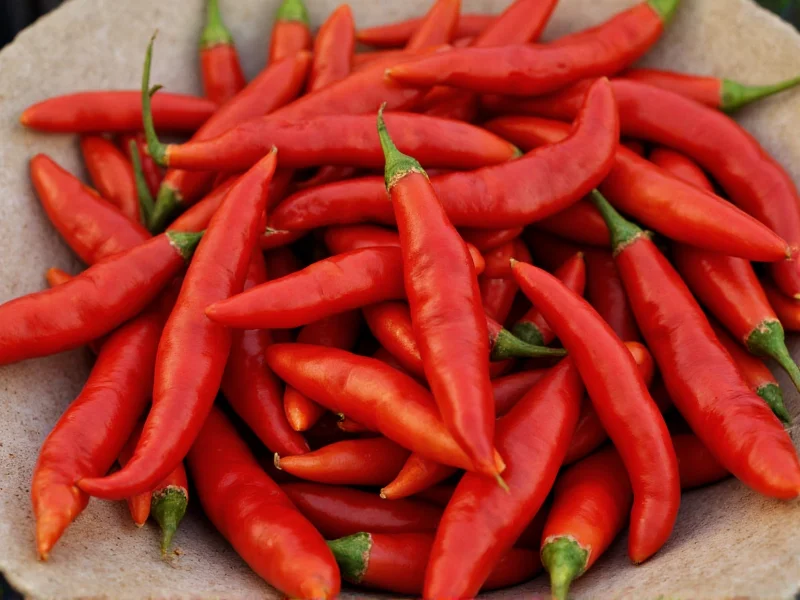When exploring are guajillo chilies hot for your cooking adventures, understanding their precise heat level is essential for recipe success. These dried mirasol peppers offer more than just warmth—they deliver a complex flavor experience that has made them a staple in traditional Mexican cooking for centuries.
Understanding Guajillo Chili Heat Measurement
Guajillo chilies register 2,500-5,000 SHU on the Scoville scale, which measures capsaicin concentration. To put this in perspective, they're approximately half as hot as the average jalapeño (which ranges 2,500-8,000 SHU) and significantly milder than cayenne peppers (30,000-50,000 SHU). This moderate heat level makes guajillos accessible to most palates while still providing noticeable warmth.
The heat in guajillo chilies concentrates primarily in the seeds and inner membranes. When preparing recipes asking how hot are guajillo chilies, smart cooks remove these parts to control spiciness. Interestingly, growing conditions significantly impact final heat—chilies from drier climates often develop more capsaicin as a natural defense mechanism.
Guajillo Heat Compared to Common Chilies
| Chili Variety | Scoville Heat Units | Heat Level Comparison |
|---|---|---|
| Guajillo | 2,500-5,000 SHU | Mild to medium (baseline) |
| Jalapeño | 2,500-8,000 SHU | Slightly hotter than guajillo |
| Chipotle | 2,500-10,000 SHU | Comparable to hotter guajillos |
| Thai Bird's Eye | 50,000-100,000 SHU | 10-20x hotter than guajillo |
| Habanero | 100,000-350,000 SHU | 20-70x hotter than guajillo |
Flavor Profile Beyond the Heat
While answering are dried guajillo chilies hot, it's crucial to recognize their nuanced flavor profile. These chilies offer:
- Tangy, cranberry-like acidity
- Subtle tea and green tea notes
- Earthy undertones with hints of berries
- Light smokiness (though less than chipotles)
This complex flavor makes guajillos valuable even for those sensitive to spice. Many cooks seeking how spicy are guajillo peppers discover they can use generous amounts without overwhelming heat, allowing the rich flavor to shine through in sauces, stews, and marinades.
Practical Cooking Applications
Understanding guajillo chili heat level helps determine their best culinary uses:
For mild heat lovers: Use whole dried guajillos in soups and stews, removing them before serving. This infuses flavor with minimal heat.
For medium heat preference: Toast and rehydrate guajillos, then blend into sauces. Retain some seeds for balanced warmth.
Heat adjustment tip: When answering are guajillo peppers spicy enough for your taste, remember you can always add heat but never remove it. Start with fewer seeds and build up.
Factors Affecting Guajillo Heat Level
Several elements influence how hot guajillo chilies really are:
- Harvest timing: Fully mature chilies develop more capsaicin
- Drying method: Sun-dried retain more heat than oven-dried
- Storage conditions: Heat diminishes over time, especially with light exposure
- Regional variations: Mexican-grown guajillos often milder than those from other regions
When comparing guajillo vs ancho heat levels, note that anchos (dried poblanos) are generally milder (1,000-2,000 SHU) with a sweeter profile, while guajillos offer brighter acidity and slightly more heat.
Substitution Guidance
If you're wondering what is similar to guajillo chili in heat, consider these alternatives:
- Miracle chilies: Nearly identical but harder to find
- Chiles de árbol: Hotter (15,000-30,000 SHU) but similar flavor
- Pasilla chilies: Comparable heat with more raisin-like notes
- Combination approach: Mix ancho (for sweetness) and cayenne (for heat) to approximate guajillo
When substituting, remember that guajillo chili heat compared to jalapeño means you'll need less jalapeño to achieve similar warmth, but the flavor profile will differ significantly.
Handling and Preparation Tips
Maximize your experience with these guajillo chili heat management techniques:
- Dry toast first: Briefly toast whole chilies in a dry skillet to enhance flavor without increasing heat
- Proper rehydration: Soak in hot water (not boiling) for 15-20 minutes to preserve delicate flavors
- Seed control: Remove all seeds and membranes for mild applications, retain some for medium heat
- Strain carefully: After blending, strain through a fine mesh sieve to remove tough skin bits
Professional chefs addressing how to reduce guajillo chili heat often add a touch of acid (like lime juice) or sweetness (such as a small amount of honey) to balance the warmth without masking the distinctive guajillo flavor.
Frequently Asked Questions
Are guajillo chilies hotter than jalapeños?
No, guajillo chilies (2,500-5,000 SHU) are generally milder than jalapeños (2,500-8,000 SHU). While there's some overlap at the lower end of the jalapeño range, most guajillos fall below the average jalapeño's heat level.
Can I eat guajillo chilies raw?
Guajillos are almost always used dried rather than fresh. While technically edible raw, their tough skin and concentrated flavor make them unpleasant to eat without rehydration and preparation. They're primarily used to make sauces, marinades, and stews after toasting and soaking.
How can I reduce the heat of guajillo chilies in my recipe?
To reduce guajillo heat, remove all seeds and inner membranes before use. Soaking in milk instead of water can also neutralize some capsaicin. Adding acidic components like lime juice or sweet elements like honey helps balance perceived heat without compromising the distinctive guajillo flavor profile.
Do guajillo chilies get hotter when cooked?
No, cooking doesn't increase guajillo chili heat. The capsaicin concentration remains stable, though prolonged cooking can distribute heat more evenly throughout a dish. Toasting before rehydration enhances flavor but doesn't significantly alter the Scoville rating.
What's the difference between guajillo and ancho chilies' heat levels?
Guajillos (2,500-5,000 SHU) are noticeably hotter than anchos (1,000-2,000 SHU). While both are considered mild to medium chilies, guajillos provide more pronounced warmth along with their distinctive tangy, berry-like flavor, whereas anchos offer a sweeter, raisin-like profile with less heat.











 浙公网安备
33010002000092号
浙公网安备
33010002000092号 浙B2-20120091-4
浙B2-20120091-4